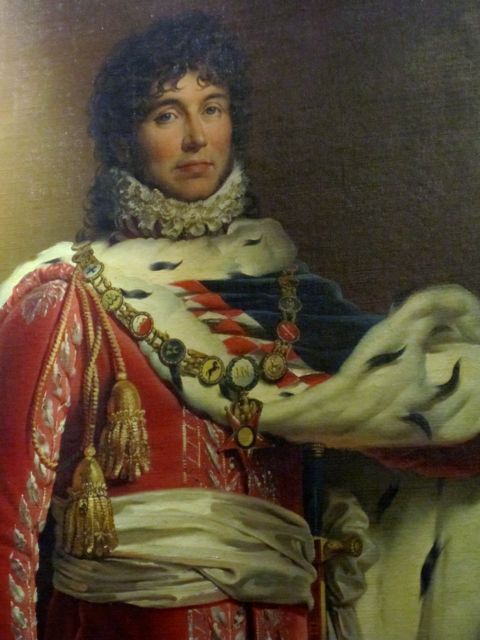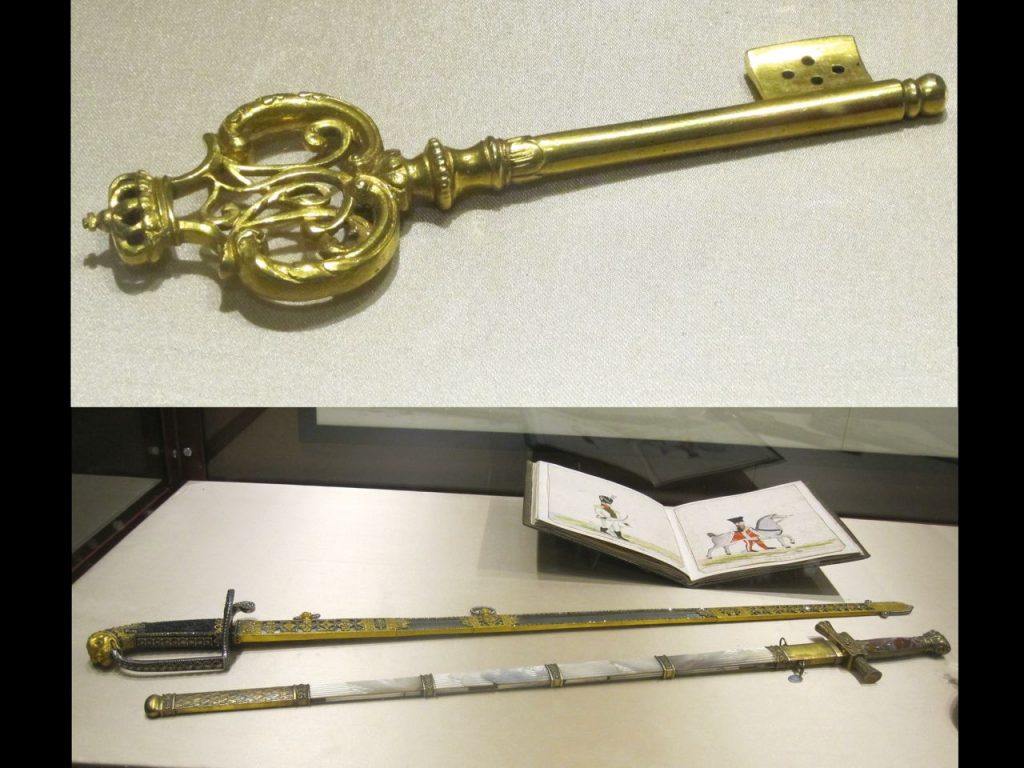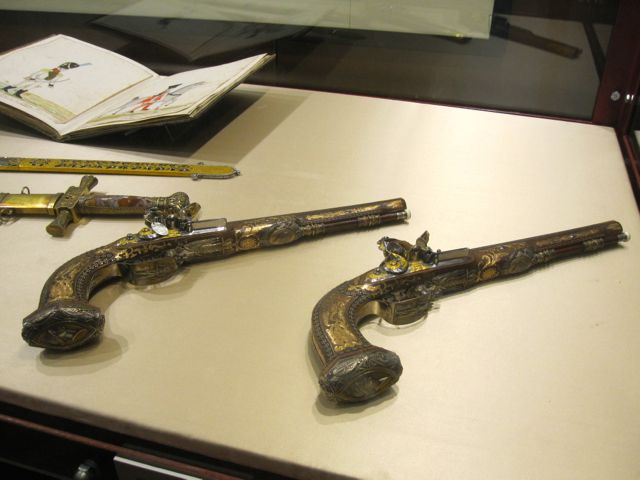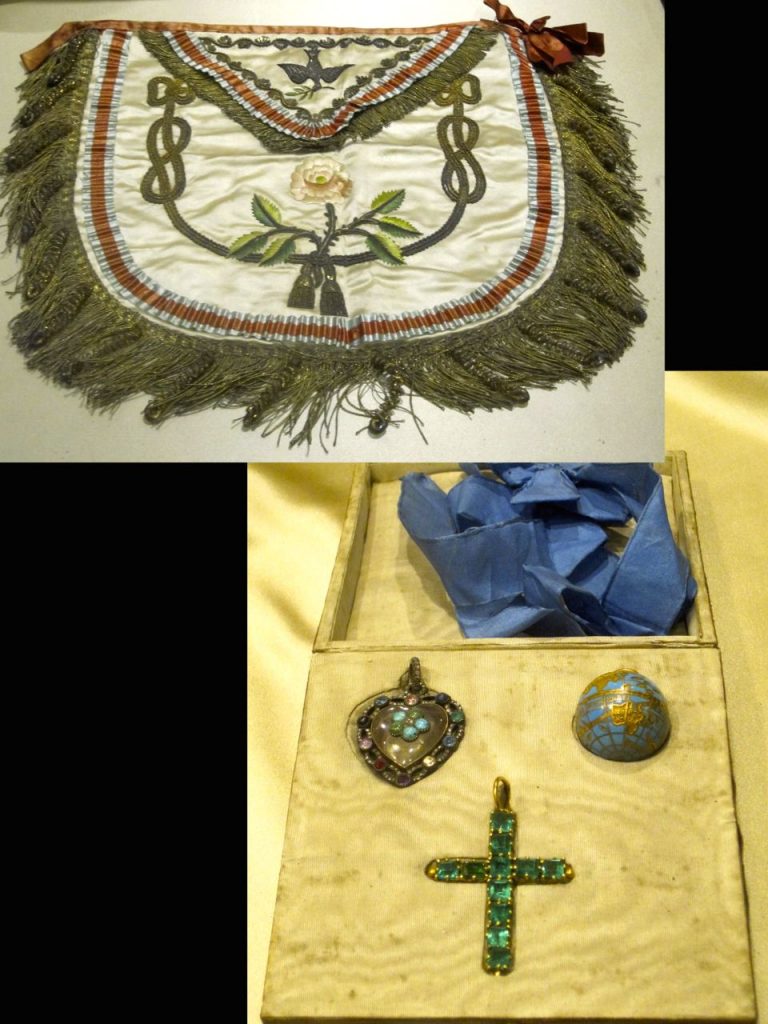THE FALL OF MURAT IN PIZZO
“Straight to the heart, but spare the face!” These were the final instructions Joachim Murat gave to his firing squad on October 13th, 1815, according to his wife’s memoirs, although Caroline Bonaparte wasn’t actually in attendance that fateful day in Pizzo as her husband and former King of Naples looked down the barrels of nine royal rifles. His attempt to re-conquer the realm by way of Calabria had been thwarted, and he met his end in the courtyard of an imposing Aragon castle overlooking the Tyrrhenian Sea.

Joachim Murat by Francois Gerard, detail
Had his face been spared, his handsome countenance saved? Some accounts say the bullets went straight through his heart, others that one grazed his face. He was buried in a common grave in Pizzo’s Church of Saint George the Martyr.
MURAT AT THE ROYAL PALACE IN NAPLES
According to all accounts, Murat was a vain man who took pleasure in donning fancy clothes. On a recent visit to Naples, I was treated to a whole host of images and other objects attesting to Murat’s tendency towards the flamboyant. The exhibition “At the Double, Murat, King of Naples” was organized to celebrate the bicentennial anniversary of Murat’s death. Held in the sumptuous Palazzo Reale (Royal Palace), the presentation featured over 150 paintings and commemorative articles, many having come from French collections and on display in Italy for the first time.
Official portraits and images with his wife and children were featured along with numerous battle scenes from Murat’s military career. He had climbed the ranks, distinguishing himself on the battlefield, and eventually married Napoleon’s sister, thus clinching various important appointments. As King of Naples from 1808 to 1815, Murat had lived in the Palazzo Reale. Informational panels at the exhibition pointed out miscellaneous acquisitions during his reign, such as a set of stools with cross-sword legs lining the “bodyguard” room adjacent to the Throne Hall.
A chamberlain’s key with Murat’s monogram was a further reminder of his time in residence.

Chamberlain’s key with Joachim Murat’s monogram and Murat’s swords
Items connected with his professional life included presentation swords and pistols.

Pair of pistols made in Versailles and given to Murat by Cambaceres
Other, more personal objects that caught my eye included his masonic apron, a small box with his portrait on ivory that was presented to him upon his departure from Naples in March 1815, and jewelry in the shape of a heart and a globe, apparently containing locks of the former sovereign’s hair.

Murat’s masonic apron and jewelry memorabilia
MURAT IN CALABRIA: ARREST AND TRIBUNAL IN PIZZO
Many paintings and prints were produced well after Murat’s demise, romanticized images of battles won and lost. Two etchings in the exhibit portrayed the arrest and condemnation of Murat in Calabria.
“The Ill-Advised Landing of Murat in Pizzo” places the goddesses of Justice and Discord in the image along with Murat as he is arrested on the beach by armed townsfolk, who just happened to be dressed to the nines and lined up in format for the occasion. Justice is clearly the winner.
“The Execution of Murat in Pizzo” sets the entire action under one outdoor canopy in a very ceremonial fashion with all the prominent parties fitting nicely within the boundaries of the picture frame.
Visiting the castle itself in Pizzo, I was met with different images, more colorful ones, such as the room in which Murat’s fate was decided by the tribunal of three, vividly attired in full uniforms with elaborate hats and epaulettes. Mannequin soldier-prisoners lounged in dungeon cells, and Murat’s own private quarters for his six-day stay were complete with an old mangy bed and a little wooden stool, albeit several levels above the dungeon. On the writing desk was a copy of the letter he had penned to his wife on the day he died. The exhibition in Naples had a manuscript in Italian of this final communication in which he says “addio” numerous times to his wife and four children, blessing them, begging not to be forgotten.
MURAT’S MEMORY
Murat hasn’t been forgotten, especially not in Pizzo where the anniversary of the events up to and including his death are celebrated annually, particularly in the bicentennial year, with reenactments, conferences and other festive activities. His memory is also kept alive by those who saw him as a hero with “the dream of an Italy unified by the South,” as stated in one of the interpretive panels in the Naples’ exhibition.
And children as well as the young at heart enjoy a quick roam around Pizzo’s majestic, but modest castle.
Visit Pizzo Castle on the CALABRIA CULTURAL TOUR!
Read more about Pizzo and Murat, as well as this fascinating region in Southern Italy that is full of history and culture, in my award-winning non-fiction book Calabria: The Other Italy, available in paperback and e-book formats.
Interested in castles? Check out my blogposts: The Castle of Roseto Capo Spulico: Templars, Tuna and Truffles in Calabria, The Castle of Sant’Aniceto in Motta San Giovanni and The Castle of Amendolea, A Ghost Town in Calabria. Visit the Murat Castle on my Calabria Cultural Tour!
“Like” Calabria: The Other Italy’s Facebook page and follow me on Karen’s Instagram and Karen’s Twitter for more beautiful pictures and information.
Sign up below to receive the next blog post directly to your email.










Comments 2
Nice picture of you & your ‘soldier friends’!
What had Murat done, to warrant his removal as King of Naples?
Author
Thanks. History’s a bit complicated. The Congress of Vienna wanted to remove him and return the Kingdoms of Naples and Sicily to their pre-Napoleonic rulers, so Murat threw his lot in with Napoleon, who had just escaped from Elba and was rallying forces. To save his crown, Murat declared war on Austria and he was defeated.